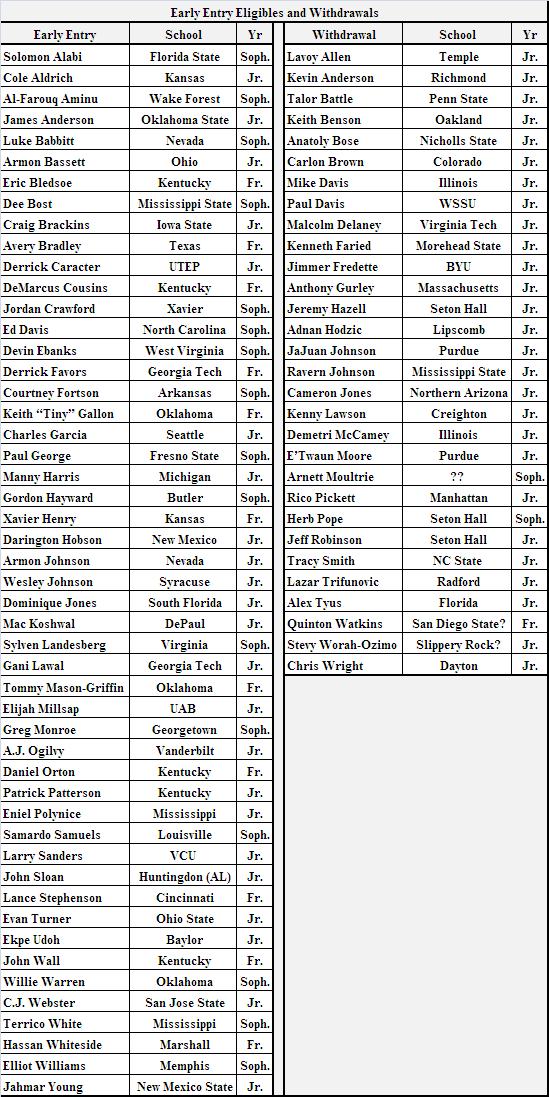The Two-Week Early Entry Withdrawal Deadline Must Go
Posted by rtmsf on May 10th, 2010If you regularly read this site, you know that the early entry withdrawal deadline for the NBA Draft passed with much zero fanfare at 5 pm ET on Saturday afternoon. Prospective draftees, many of whom were in the middle of exam periods at their schools, had a mere two weeks to make a final decision whether to take the plunge and give up their collegiate eligibility for the dream of NBA riches. The two-week window for withdrawal is a new NCAA rule designed to engender program continuity and recruiting at the expense of the student-athletes they purport to care about. The elephant in the room question is whether players on the fence about declaring for the draft had enough time to be able to properly consider and assess their draft prospects, and the short answer appears to be that they did not. Surprise surprise.
Let’s take a quick comparative snapshot of last year’s early entry pool versus this year’s. The 2009 early entries had an additional five-plus weeks to work out for teams, attend the draft combine and communicate with scouts, coaches and family members before making a final call on the matter. It’s quite possible that two months was too much time, but the salient point is that they had plenty of it from which to make an informed decision. From a pool of 74 underclassmen who originally declared for the NBA Draft, nearly half withdrew resulting in a final total of 39 early entries, two-thirds (26) of whom were ultimately drafted. This year there was a rough equivalent of 80 early entries, but only 30 of those players withdrew by Saturday afternoon’s deadline, leaving 50 hopeful underclassmen jockeying for positions in a 60-pick draft (see above list). Keep in mind that there are numerous international prospects as well as seniors such as Luke Harangody, Damion James, Jarvis Varnado and Jerome Jordan who will also be chosen in late June.
The key problems are apparent:
-
NBA teams are not evaluating players yet. As of last week, there were still eight teams playing games, and the others were still closing out their seasons. According to Louisville head coach Rick Pitino who was trying to get information for his sophomore center Samardo Samuels, only one of the thirty NBA teams held player evaluations prior to this year’s May 8 deadline. If the idea behind ‘testing the waters’ is for players to receive accurate evaluations of their game from professional scouts, then we’re at a loss in understanding how this date makes any sense whatsoever.
-
The Chicago Pre-Draft Camp needs to move. This camp that takes place in late May/early June allows fence-sitting players to see how they stack up in drills and workouts against their peers rather than trying to patch together a guesstimate based on little more than rumor and third-hand information. Obviously, the NBA does not care about appeasing the NCAA, but perhaps Stern & company could be persuaded to move it up by a couple of weeks to reach a happy medium. Otherwise, if it doesn’t move, then the NCAA needs to give in and make the deadline fit the calendar of this camp.
Looking at the list of early entries above, we see more than a few names who are likely to be incredibly disappointed come draft night — from Bassett to Young and numerous faces in-between, we wonder if these players would have made the same decision if they’d actually been able to, you know, test the waters, as the original concept of the rule was intended.











































